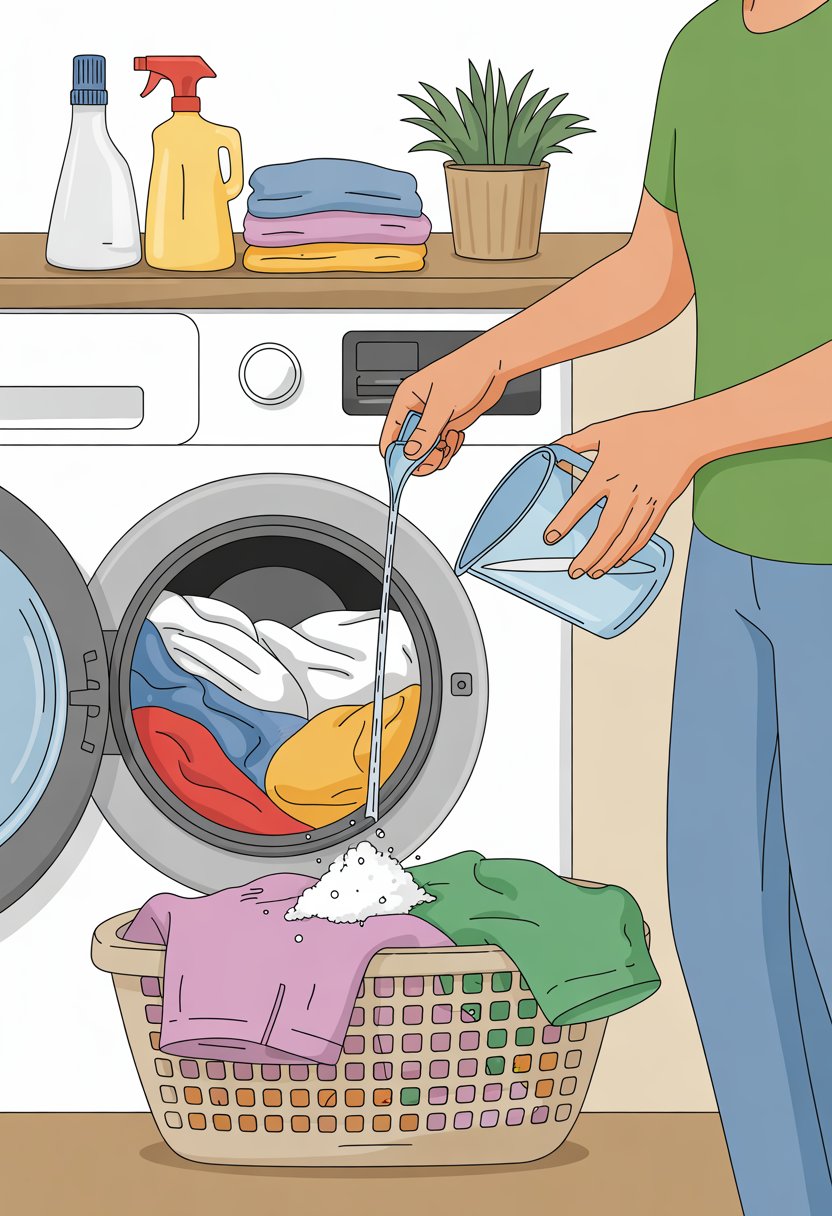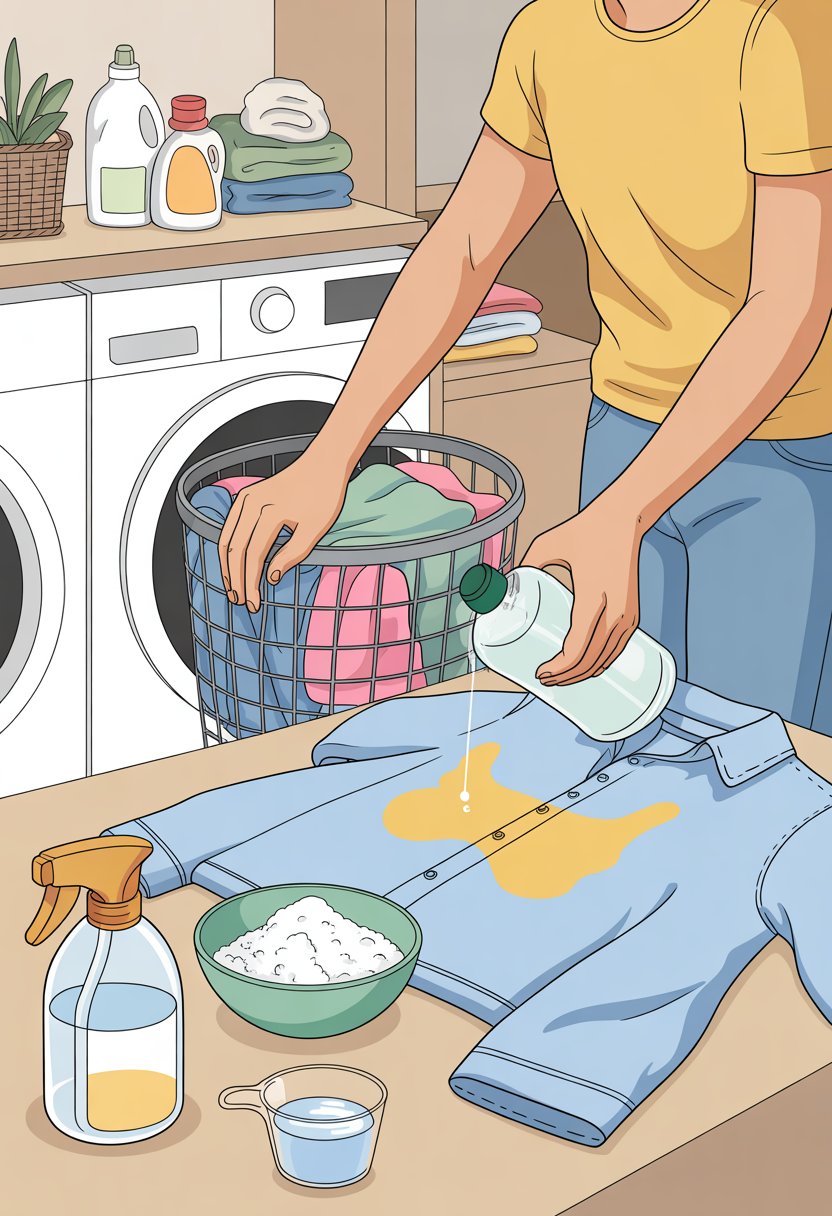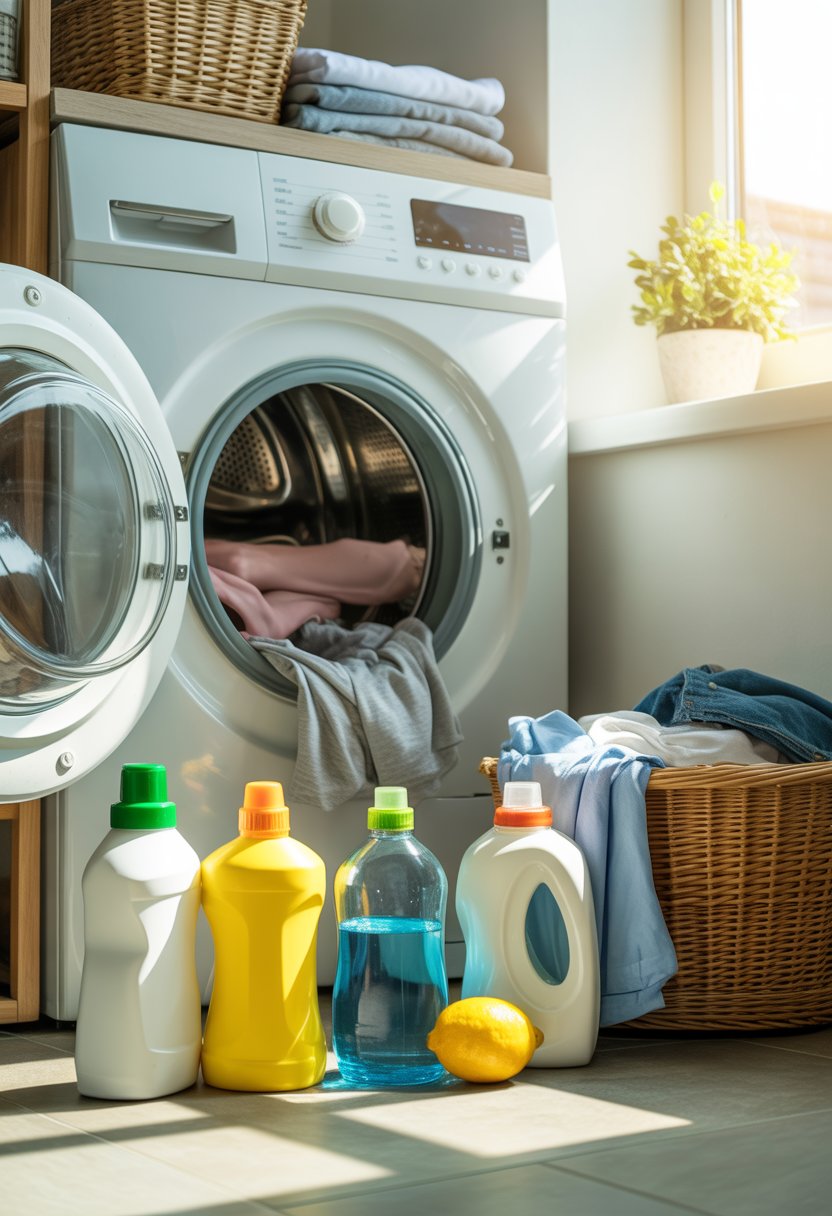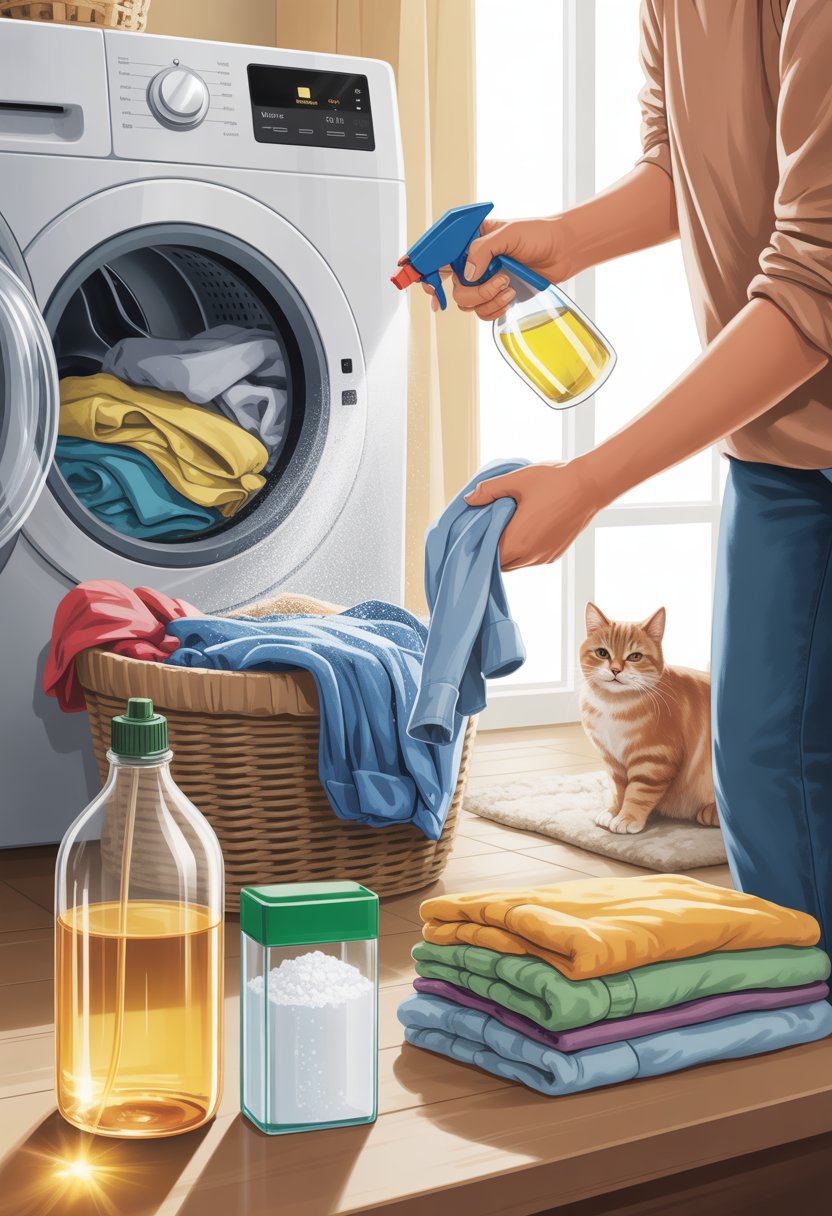
Cat urine on clothes—ugh, right? It’s a hassle, but you don’t need fancy, overpriced cleaners to deal with it. If you act fast and grab the right stuff from your kitchen, you can break down those stubborn, stinky compounds.

You can actually get rid of cat pee smell from clothes with basics like white vinegar, baking soda, and hydrogen peroxide. These household staples neutralize ammonia and bacteria, which are the main culprits behind that nose-wrinkling odor.
There’s a process, though. Timing matters, and you’ll want to know how to prep your clothes and which item to use for which fabric.
Act Quickly: Why Immediate Action Matters
When cat urine sits and dries on fabric, it becomes way harder to remove. The smell gets worse, and your clothes can take a hit.
Risks of Delayed Cleaning
Uric acid crystals in cat pee start bonding with fabric fibers almost immediately. The longer you wait, the more they dig in.
If the urine is still fresh, you can blot most of it away. Wait 30 minutes, though, and it starts soaking deeper into the weave.
In just a few hours, bacteria show up and start feeding on the urine. That’s when things get extra smelly—worse than the original accident.
Warmth from your home or sunlight only speeds up these chemical reactions. Odors get locked in, and it’s a pain to get them out.
Your washing machine just can’t handle set-in stains as well. You might end up running the same item through multiple loads.
Preventing Permanent Odor
If uric acid crystals dry into the fabric, they’re almost impossible to remove with regular detergent. That’s when you really regret not acting sooner.
The ammonia smell doesn’t just linger—it intensifies as water evaporates and compounds concentrate.
Blotting right away can get rid of up to 80% of the liquid. Grab paper towels or a clean cloth and soak up as much as you can.
Stick with cold water for rinsing. Hot water just makes those proteins cling to the fabric even harder.
If you can get to it within the first 15 minutes, you’ve got the best shot at removing the smell entirely. Miss that window, and you’ll need to bring out the heavy-duty cleaners.
Protecting Fabric Quality
Cat urine is acidic, and it’ll eat away at fabric fibers. Cotton and wool don’t stand a chance if you let the stain sit.
Colors can fade or shift where the urine touched. The acid can mess with dyes, leaving permanent discoloration.
If you put off cleaning, you’ll end up washing the item over and over. That just wears it out faster.
Some materials—silk or delicate synthetics—get damaged fast. The acid just chews right through them.
If you want your clothes to last, deal with stains right away. It saves you from both nasty smells and ruined fabric.
Preparing Clothes Before Washing

Move quickly when you spot cat urine on clothes. Get rid of as much liquid as you can, and rinse before tossing anything in the wash.
Removing Excess Cat Urine
If the stain’s fresh, grab some paper towels or a clean rag and press down hard to soak up the liquid. Don’t rub—you’ll just spread the mess.
Work from the outside in. That way, you keep the stain from creeping into clean fabric.
If you’re dealing with dried stains, you’ll need to loosen things up. Mix equal parts cold water and white vinegar in a spray bottle and hit the area.
Let it sit for a couple minutes, then blot again. You might need to treat each layer if the stain soaked through.
Blotting and Rinsing Techniques
Always use cold water to rinse out cat urine. Hot water will just make the smell worse.
Put the stained part under running cold water, letting it flow from the back side. That helps push the urine out instead of deeper in.
Blot—don’t rub—with a clean cloth or paper towel. Swap out for fresh ones when they get wet.
Keep rinsing and blotting until the water runs clear. It usually takes a few minutes.
Give it a quick sniff while it’s still damp. If you pick up any odor, rinse again. You want it smelling neutral before moving on.
Household Items That Eliminate Cat Pee Smell
Three basics from your pantry or medicine cabinet can wipe out cat urine odor: baking soda, white vinegar, and hydrogen peroxide. Baking soda absorbs, vinegar neutralizes ammonia, and peroxide breaks down uric acid crystals.
Baking Soda Method
Baking soda’s great for soaking up moisture and neutralizing odors. It draws out the liquid and gets rid of the smell naturally.
For fresh stains:
- Blot up as much urine as you can
- Sprinkle baking soda all over the wet spot
- Let it sit for 15–20 minutes
- Brush off the powder
- Wash in cold water
For dried stains:
- Mix a cup of baking soda with a cup of warm water
- Soak the area for half an hour
- Gently scrub with an old toothbrush
- Rinse with cold water, then wash
When the powder clumps up, it’s doing its job—pulling those odor compounds out.
White Vinegar Application
White vinegar’s acetic acid goes after the ammonia in cat pee. The reaction kills that sharp smell.
Mix equal parts white vinegar and water. Pour it right onto the stain.
Let it sit for 10–15 minutes. The vinegar smell fades as it dries, and the pee odor goes with it.
Rinse with cold water, then wash as usual.
A few things to remember:
- Stick to clear vinegar, not the colored kind
- Test on a hidden spot first if you’re nervous
- Don’t mix vinegar and bleach (seriously, just don’t)
Vinegar’s acid breaks down those lingering uric acid crystals.
Using Hydrogen Peroxide
Hydrogen peroxide oxidizes uric acid crystals, busting up the stuff that makes cat pee so persistent.
Grab some 3% hydrogen peroxide and mix it half-and-half with water in a spray bottle.
Spray it on the stain. If you see bubbles, that means it’s working.
Let it sit for 5–10 minutes, then rinse with cold water. The bubbling helps lift stains and odors.
A couple quick warnings:
- Test on a hidden spot first
- It might lighten dark fabrics
- Skip it on delicate stuff
- Rinse well afterward
It works best on fresh stains, but it can help with older ones too.
Step-By-Step Washing Instructions
Cold water keeps cat urine from setting into fabric. You’ll want the right machine settings and cycles to break down odors. Air drying is usually better than heat drying—heat can lock in smells you thought you’d banished.
Cold Water Pre-Soak
Fill a sink or big bowl with cold water. For every two cups of water, toss in a cup of white vinegar.
Submerge the soiled clothes, making sure they’re completely covered.
Let them soak for at least 30 minutes. If the stain’s old, leave them for a couple hours.
Vinegar goes after the uric acid—the main reason cat pee smells so strong and won’t budge with regular detergent.
Give the fabric a gentle squeeze every 10 minutes or so. That helps the vinegar solution get deep into the fibers.
When you’re done, lift the clothes out. Don’t wring them out too hard, or you might damage the fabric.
Washing Machine Settings
Set your washer to use cold water. Hot water will just make the urine smell stick around forever.
Add your usual laundry detergent—don’t overdo it, just use the amount on the label.
Pour a cup of white vinegar into the fabric softener compartment. If your machine doesn’t have one, add it during the rinse.
Pick the longest wash cycle your machine offers. More time means more odor-fighting action.
Skip the fabric softener. It can trap smells in the fibers.
Air Drying Versus Machine Drying
Air drying is your best bet for clothes you’ve treated for cat urine. Dryer heat can seal in any leftover smells.
Hang clothes outside if you can. Sunlight is a natural bacteria killer and helps break down lingering compounds.
If you’re drying inside, pick a breezy, well-ventilated spot. Use a rack and keep it away from heaters.
Give clothes a good sniff when they’re dry. Check all over—sometimes the smell hides.
If you catch even a hint of pee, wash again. Don’t risk the dryer until you’re sure the odor’s gone.
If you do use the dryer, go for the lowest heat, and only after you’re positive the smell is history.
Tackling Stubborn Odors

Sometimes, cat urine odors just refuse to quit after one wash. A second round with stronger solutions and some good old-fashioned fresh air can finally do the trick.
Second Wash Solutions
Run the clothes through another wash, this time adding two cups of white vinegar straight into the drum.
If your fabric can handle it, use hot water. The heat can help break down any uric acid crystals that survived round one.
Still skip the fabric softener. It’s just going to trap whatever’s left in the fibers.
For a little extra oomph, throw in a cup of baking soda along with the vinegar. The fizz helps lift odors out.
After this wash, check the clothes while they’re still damp. Give them a sniff test. If you still smell anything, wash again before you even think about drying.
Sunlight and Fresh Air Exposure
Hang your clothes outside in direct sun after washing. UV rays are great at killing odor-causing bacteria that your washer might miss.
Fresh air helps carry away any lingering smells. Even a gentle breeze does wonders.
Leave them out for at least 4–6 hours, and flip them inside out halfway through so both sides get sun.
Skip the dryer until you’re absolutely sure the smell is gone. Otherwise, you’ll just bake it in.
If you can’t hang clothes outside, put them near an open window with good airflow. It takes longer, but it still helps.
Preventing Future Cat Pee Incidents

Keep your cat’s litter box clean and pay attention to behavior changes. Remove tempting items, and you’ll have way fewer accidents to clean up.
Litter Box Maintenance
Scoop your cat’s litter box every day. Grab waste and clumps as soon as you spot them.
Once a week, swap out all the litter. Give the box a scrub with mild soap and warm water while you’re at it.
Location matters for litter boxes:
- Put boxes in quiet, low-traffic spots.
- Keep them far from food and water bowls.
Always have one box per cat, plus an extra. Try not to move the boxes around too much—cats really notice.
Use unscented litter. Honestly, most cats turn their noses up at strong fragrances.
Pour in about 2-3 inches of litter. If you go way over or under, your cat might get picky.
Swap out old litter boxes every year. Even with regular cleaning, scratches and weird odors just build up.
Discouraging Repeat Behavior
Grab an enzyme cleaner and tackle accident spots right away. If you use regular detergents, they’ll leave behind scents, and your cat will probably return to the scene of the crime.
Block access to problem areas:
- Try placing food and water bowls right on top of those accident zones.
- Cover up the areas with aluminum foil or some plastic sheeting—it’s not pretty, but it works.
- Motion-activated air sprayers can really spook a cat away from favorite trouble spots.
Take a look at what’s stressing your cat out. Maybe it’s a new pet, a sudden change in your schedule, or just too much noise—any of these can lead to inappropriate urination.
If the accidents keep happening, it’s time to call the vet. Sometimes, things like urinary tract infections are the real culprit behind litter box issues.
Keep clothes off the floor and out of laundry baskets. Cats seem to think fabric piles are fair game for bathroom breaks.

